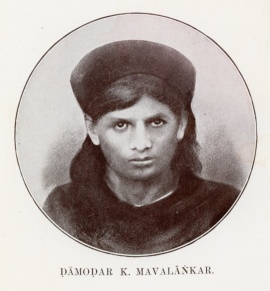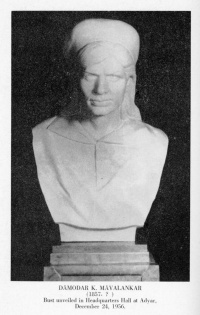Damodar K. Mavalankar: Difference between revisions
Pablo Sender (talk | contribs) No edit summary |
No edit summary |
||
| Line 22: | Line 22: | ||
== Demonstrations of psychic ability == | == Demonstrations of psychic ability == | ||
[[File:Damodar seated.jpg|right|200px|thumb|Damodar]] | |||
Damodar was involved in demonstrations of psychic phenomena offered by [[Henry Steel Olcott|Colonel Olcott]] to members of the [[Society for Psychical Research]]. | Damodar was involved in demonstrations of psychic phenomena offered by [[Henry Steel Olcott|Colonel Olcott]] to members of the [[Society for Psychical Research]]. | ||
Revision as of 17:47, 20 November 2024

Dāmodar Keshav (or Keshub) Mavalankar (born September 1857 in Ahmedabad) was an Indian Theosophist and a chela of Mahatma Koot Hoomi.[1][2][3]
Early life
He was born in the family of the Karhâda Mahârashtra caste of Brâhmanas,[4] a wealthy Indian family. His father was Keshav Narsingh Mavalankar, first president of the Blavatsky Lodge in Bombay.[5] Apart from learning the tenets of his religion by his father from an early age, he also received a very good English education. When he was ill as a child, he met his guru Koot Hoomi, who promised to take him under his protection.[6] The name Mavalankar is pronounced with the stress on the first syllable, but no accent is necessary.[7]

Association with Theosophical Society
In 1879 he met H. S. Olcott and H. P. Blavatsky in Bombay, after they had just established the Theosophical Society's temporary Indian headquarters there. "On August 3, 1879, he joined the Society at Bombay; several of his relatives, including his father and his uncle, also became members."[8] Damodar, however, went a step further, giving up his caste. In 1880, he officially became a Buddhist while in Sri Lanka, taking Pancha Sila along with Col. Olcott and Madame Blavatsky.[9] His actions displeased his family and led to conflict, due to them desiring him to return home and live with his wife, who was betrothen to him in his childhood, or face the consequences of being cut out of his will. In response to this, Damodar gave up an income of 50,000 Indian rupees to provide for the future of his would-be wife, and continued to live and work with the Theosophical founders.
After meeting H. P. B. his interior vision gradually opened and again he knew the Guru of his childhood vision, his Master K. H., which sealed his devotion to theosophy. His remarkable psychic powers made him the centre of many phenomena. Between 25-27 Nov. '83 he visited the ashram of his master to undergo certain training. From frail, timid, deferential, he returned bronzed, robust, bold, energetic.[10]
Damodar wrote a number of excellent articles for The Theosophist, which were compiled by Sven Eek in Damodar: The Writings of a Hindu Chela. The compilation also includes some very interesting correspondence with William Quan Judge, A. P. Sinnett, and Mrs. Josephine W. Cables, of Rochester, New York, and various reports and other documents. All are dated in the range 1879-1886.
He continued his work in this way until February 23, 1885, when he went to Tibet to join his Master. "Almost alone among hundreds of other earnest aspirants was he found qualified to proceed to the Tibetan mountain-home... of the Mahatmans Koot Hoomi and Morya."[11] Wearing Tibetan disguise he was brought to the frontier by his escort. Confirmation was sent by the ashram in June 1886 stating that Damodar was alive and safe.[12][13]
Demonstrations of psychic ability

Damodar was involved in demonstrations of psychic phenomena offered by Colonel Olcott to members of the Society for Psychical Research.
Damodar is Secretary to the Theosophical Society, and a Brahmin of high caste. At Moradabad, on the evening of the 10th November, 1882, he announced apropos of a decision by Colonel Olcott, that he would go in the double or phantasm to the Headquarters of the Society, more than 1,000 miles away, and obtain a modification of it. He shut himself up in his room, came out in a few minutes and gave a message purporting to come from Headquarters, situated at Adyar, a suburb of Madras. The message was taken down and attested by several witnesses. He then added that a confirmation of it would come by telegram, and this actually occurred the next morning...
The other Damodar case is of a similar character; he announced an accident to Madame Blavatsky which was only made known by telegram the next day and which he could not have possibly ascertained in the ordinary way.[14]
HPB related an account of Damodar speaking with his astral voice, in a letter to Colonel Olcott on November 11, 1883:
Last night about 5 pm, as I was cleaning the portraits in the Shrine and M. Coulomb was in my bedroom walling with two masons the window; I suddenly heard Damodar’s voice! I did not believe my ears at first.―I saw like a cloud, whitish, transparent, flickering moving from Shrine to my table and from table again to Shrine, but his voice came from the latter as though through Mahatma Kashmir’s portrait,[15] and yet Damodar’s voice. He was telling me of some Shanker or Sander Sing, asking your mesmeric help for some boys and invalids at Moradabad, and praying that I should beg of the Masters to give permission or ask for instructions. “I promised them to come to you personally in my astral soul (?!) and deliver them the Master’s answer to that effect. Please telegraph to me to Moradabad the answer you will now have.”
“But I have no answer —” I said “and suppose Master does not choose to answer me . . .” And then a thought struck me and I told to what I supposed was Djual-Khool playing tricks with me & taking Damodar’s shape―“Now don’t be bamboozling me, Master Benjamin!”[16] But I then heard M∴ Sahib’s voice who spoke very seriously and said very loud―“You are mistaken―it’s Damodar. Tell him to say so & so” ― (what I telegraphed, I now forget, but he made me write under his dictation then). And then the flickering cloud―Damodar’s abortive attempts to materialize thoroughly, I suppose―disappeared after some words in Maratha as though thanking the master―“Gurudeva” he called Him. Mr. Coulomb came suddenly into the room exclaiming―“Ah! Mr. Damodar est done de retour? Où est-il?” [Fr. “Damodar has returned? Where is he?”] ―I told him he must have been dreaming; that Damodar was not “de retour” [Fr. “returned”]. But he insisted that he had heard his voice!! And then Baboola joined chorus, & swears to me that he heard Damodar speak to me from the passage. Well, I be hung, if Damodar is not developing at the rate of 60 miles an hour.[17]
Mahatma Letters

Under the direction of his master Koot Hoomi, Damodar wrote to A. P. Sinnett. His letters appear in The Mahatma Letters to A. P. Sinnett as number 14a (Barker no. 142a) and number 14b (Barker no. 142b). He provided information to Mr. Sinnett about the existence of the Mahatmas, and about initiation fees for members of the Theosophical Society.
He was mentioned in Mahatma Letter No. 65 as a person who could convey papers from Sinnett and Hume to the Mahatmas.
Writings
Online versions of most of Damodar's writings at Universal Theosophy website.
Books
Damodar wrote materials that were published posthumously in three noteworthy books.
- Damodar, The Writings of a Hindu Chela compiled by Sven Eek. See also Biographical notes. Originally published in 1940 by Theosophical University Press, Point Loma, California.
- The Service of Humanity. Concord Grove Press, 1982.
- Damodar and the Pioneers of the Theosophical Movement. Wheaton, Illinois: Quest Books, 1978. Includes many detailed biographies of important Theosophists who helped Madame Blavatsky.
Articles
These are some of the articles written for The Theosophist. They are available online at the Theosophical University Press online:
- "The Swami of Akalkot" January, 1880.
- "Castes in India" May, 1880.
- "The Vedantasara" September, 1883.
- "Vedantism and Buddhism" August, 1884. Comment by "An Enquirer" on "The Vedantasara" with Damodar's Note appended.
- "Kavya Dosha Vivechana" October, 1883.
- "The Work of the Branches" Supplement to The Theosophist, January, 1884.
- "The Work of the Branches" Supplement to The Theosophist, March, 1884.
- "Oxford Mission Shots at Occultism" Supplement to The Theosophist, January, 1884.
- "White and Black Magic" Supplement to The Theosophist, February, 1884.
- "Contemplation" February, 1884.
- "Contemplation" April, 1884. Comments on previous article by "F. T. S." with Damodar's Note appended.
- "Contemplation - II" August, 1884.
- "The Philosophy and Science of Vedantic Raja Yoga" March, 1884. Edited by Babu Siris Chandra Vasu, B. A., F. T. S.
- "The Metaphysical Basis of 'Esoteric Buddhism' May, 1884.
- "The 'Occult World' and the 'Spiritualist' August, 1881.
- "Pert Questions and Plain Answers" May, 1882.
- "Answer to * * * 's Misconceptions" May, 1882.
- "Seeing Bright Light with Closed Eyes" Supplement to The Theosophist, September, 1883.
- "Can Females Become Adepts?" October, 1883.
- "'Phenomena'" Supplement to The Theosophist, April, 1884.
- "The Best Food for Man" April, 1884.
- "Esoteric Buddhism and Hinduism" June, 1884.
- "The Astral Body" January, 1885.
- "Madame Blavatsky and Colonel Olcott" Supplement to The Theosophist, December, 1881.
- "The Work of the Theosophical Society" Supplement to The Theosophist, March, 1882.
Additional resources
Articles
- 'Damodar K. Mavalankar' by Sri Raghavan Iyer
- Testimony Concerning the Mahatmas by Damodar K. Mavalankar
Websites
- The Writings of Damodar K. Mavalankar at Universal Theosophy website.
Notes
- ↑ Sri Raghavan Iyer, "Damodar K. Mavalankar" at Theosophytrust.org. Accessed November 15, 2018.
- ↑ Sven Eek (comp.), Dâmodar and the Pioneers of the Theosophical Movement, Theosophical Publishing House (TPH), 1965.
- ↑ "Mavalankar, Damodar K." The International Theosophical Year Book 1938 (Adyar, Madras, India: Theosophical Publishing House, 1938): 200.
- ↑ Damodar K. Mavalankar, "Castes in India", The Theosophist (May, 1880).
- ↑ Bombay Theosophical Bulletin 89 No. 6 (March, 2020), 5. See also the Wadia book Fifty Years of Theosophy in Bombay.
- ↑ "Mavalankar, Damodar K." The International Theosophical Year Book 1938 (Adyar, Madras, India: Theosophical Publishing House, 1938): 200.
- ↑ Curuppumullage Jinarājadāsa note to Boris de Zirkoff. 1952. Boris de Zirkoff Papers. Records Series 22. Theosophical Society in America Archives.
- ↑ C. J. Ryan, "Biographical Notes" Damodar: The Writings of a Hindu Chela compiled by Sven Eek (Covina, California: Theosophical University Press, 1940), 6.
- ↑ Henry Steel Olcott, Old Diary Leaves Vol. 2 , 1900
- ↑ "Mavalankar, Damodar K." The International Theosophical Year Book 1938 (Adyar, Madras, India: Theosophical Publishing House, 1938): 200.
- ↑ C. J. Ryan, 5.
- ↑ Henry Steel Olcott, Old Diary Leaves Vol. 3, 1904, pp. 265-6.
- ↑ "Mavalankar, Damodar K." The International Theosophical Year Book 1938 (Adyar, Madras, India: Theosophical Publishing House, 1938): 200.
- ↑ "General Meeting " Journal of the Society for Psychical Research 5 (June, 1883), 72-73.
- ↑ "Mahatma Kashmir's portrait" refers to Koot Hoomi, who was from Kashmir.
- ↑ "Master Benjamin" refers to Djual Khool]]
- ↑ This letter was published in part in The Theosophist 29 no.10 (July7 1908), 947. The complete letter will be published in HPB's Collected Letters.